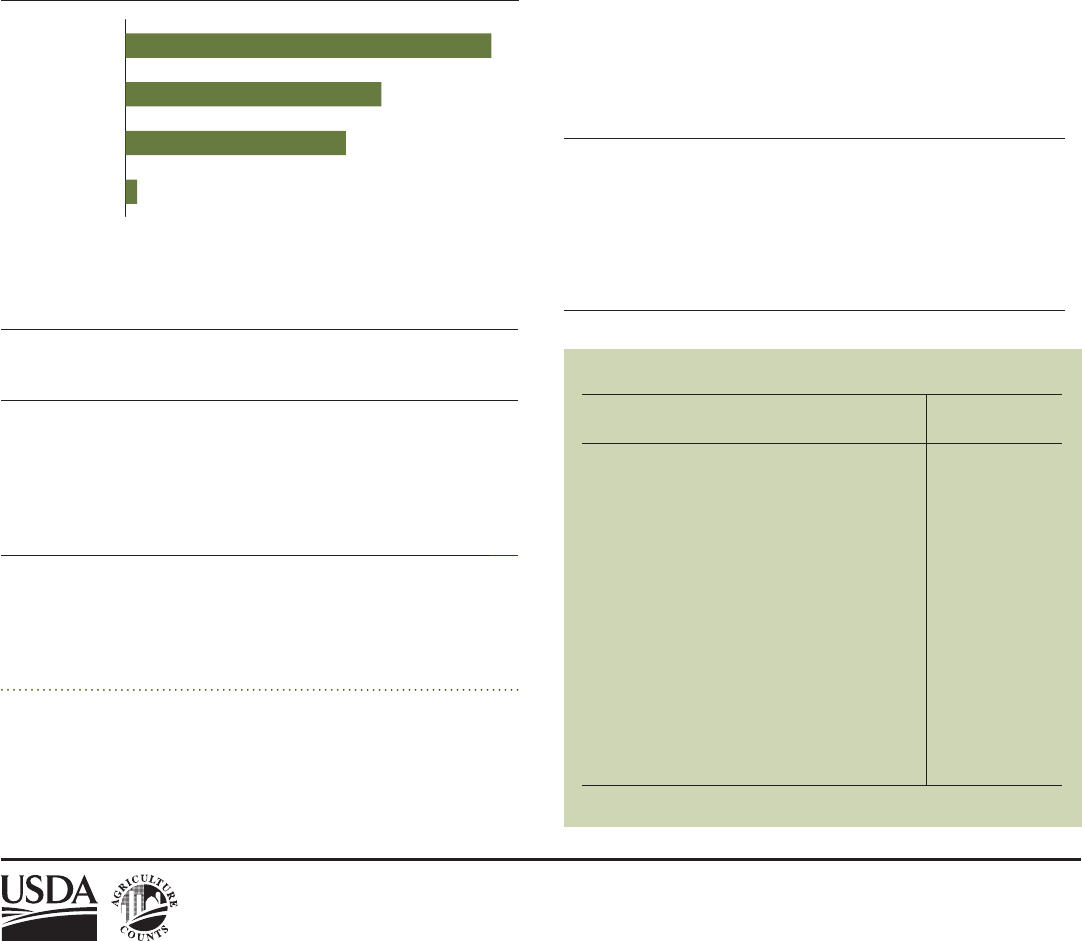
Thirteen states . . .
. . . accounted for 96.7 percent
of U.S. acres planted to cotton
in 2019.
About the Survey
The Agricultural Chemical Use
Program of USDA’s National
Agricultural Statistics Service (NASS)
is the federal government’s ocial
source of statistics about on-farm and
post-harvest commercial fertilizer and
pesticide use and pest management
practices. NASS conducts eld crop
agricultural chemical use surveys in
cooperation with USDA’s Economic
Research Service as part of the
Agricultural Resource Management
Survey. NASS conducted the cotton
chemical use survey in the fall of 2019.
Access the Data
Access 2019 and earlier cotton
chemical use data through the
Quick Stats database
(http://quickstats.nass.usda.gov).
• In Program, select “Survey”
• In Sector, select “Environmental”
• In Group, select “Field Crops”
• In Commodity, select “Cotton”
• Select your category, data item,
geographic level, and year
For pre-dened Quick Stats queries,
go to http://bit.ly/AgChem and click
“Data Tables” under the 2019 Barley,
Cotton, Sorghum, and Wheat heading.
For methodology information, click
“Methodology.”
2019 AGRICULTURAL CHEMICAL USE SURVEY
Cotton
NASS Highlights
The 2019 Agricultural Chemical Use Survey of cotton producers collected
data about fertilizer and pesticide use as well as pest management practices
in growing cotton. NASS conducted the survey among cotton producers in
13 states that together accounted for 96.7 percent of the 13.7 million acres
planted to cotton in the United States in 2019: Alabama, Arizona, Arkansas,
California, Georgia, Louisiana, Mississippi, Missouri, North Carolina, Oklahoma,
South Carolina,
Tennessee, and
Texas. (Fig. 1)
The data are for
the 2019 crop
year, the one-year
period beginning
after the 2018
harvest and
ending after the
2019 harvest.
Fertilizer Use
Fertilizer refers to a soil-enriching input that contains one or more plant
nutrients. For the 2019 crop year, farmers applied nitrogen to 86 percent of
planted acres, at an average rate of 85 pounds per acre, for a total of 968.6
million pounds.
They applied
phosphate to 61
percent of cotton
planted acres,
potash to 48
percent of acres
and sulfur to 41
percent of planted
acres. (Table 1)
AGRICULTURAL
CHEMICAL USE
AGRICULTURAL
CHEMICAL USE
www.nass.usda.gov
• No. 2020-3
May 2020
Fig. 1. States in the 2019 Cotton Chemical Use Survey
Table 1. Fertilizer Applied to Cotton Planted Acres, 2019 Crop Year
% of
Acres with
Nutrient ª
Avg. Rate
for Year
(lbs/acre)
Total
Applied
(mil lbs)
Nitrogen (N) 86 85 968.6
Phosphate (P
2
O
5
) 61 42 345.1
Potash (K
2
O) 48 73 460.5
Sulfer (S) 41 14 75.2
a
Acres with multiple nutrients are counted in each category.
United States Department of Agriculture
National Agricultural Statistics Service

Pesticide Use
The pesticide active ingredients used on cotton are
classied in this report as herbicides (targeting weeds),
insecticides (targeting insects), fungicides (targeting
fungal disease), and other chemicals (targeting all
other pests and other materials, including extraneous
crop foliage). Herbicides were used most extensively,
with application to 93 percent of planted acres. Other
chemicals were applied to 65 percent of planted acres,
insecticides to 56 percent. (Fig. 2)
Among herbicides, two dierent forms of glyphosate
were the most widely applied active ingredients,
followed by dicamba diglycolamine salt. (Table 2)
Fig. 2. Pesticides Applied to Cotton Planted Acres, 2019 Crop Year
(% of planted acres)
Fungicides
Herbicides
Insecticides
Other Chemicals
3
56
65
93
Table 2. Top Herbicides Applied to Cotton Planted Acres,
2019 Crop Year
Active
Ingredient
% of
Acres with
Ingredient ª
Avg. Rate
for Year
(lbs/acre)
Total
Applied
(mil lbs)
Glyphosate isopropylamine salt 55 1.740 12.8
b
Glyphosate potassium salt 32 2.138 9.2
b
Dicamba diglycolamine salt 21 1.180 3.2
b
Diuron 20 0.489 1.3
Triuralin 16 0.934 2.0
a
Acres with multiple ingredients are counted in each category.
b
Expressed in acid equivalent.
Pest Management Practices
The survey asked growers to report on the practices
they used to manage pests, dened as weeds, insects,
or diseases. Cotton growers reported practices in four
categories: prevention, avoidance, monitoring, and
suppression (PAMS).
• Prevention practices involve actions to keep a pest
population from infesting a crop or eld.
• Avoidance practices use cultural measures to
mitigate or eliminate the detrimental eects of
pests.
• Monitoring practices observe or detect pests by
systematic sampling, counting, or other forms of
scouting.
• Suppression practices involve controlling or reducing
existing pest populations to mitigate crop damage.
The most widely used prevention practice in growing
cotton was cleaning equipment and implements
after eld work, used on 61 percent of planted acres.
The top avoidance practice was choosing crop or
plant varieties for their resistance to specic pests (61
percent). Scouting for weeds was the most widely used
monitoring practice (91 percent), and using pesticides
with dierent mechanisms of action was the top
suppression practice (45 percent). (Table 3)
Table 3. Top Practice in Pest Management Category, 2019
(% of cotton planted acres)
Prevention: Cleaned equipment and implements after eld work 61
Avoidance: Chose crop variety for specic pest resistance 61
Monitoring: Scouted for weeds (deliberately, or by general
observations while performing other tasks) 91
Suppression: Used pesticides with dierent mechanisms of action to
prevent pests from developing resistance 45
USDA is an equal opportunity provider, employer, and lender.
www.nass.usda.gov
Surveyed States: Acres of Cotton Planted, 2019
thousands of acres % of U.S.
U.S. Total 13,738 100
Texas 7,062 51.4
Georgia 1,400 10.2
Mississippi 710 5.2
Oklahoma 640 4.7
Arkansas 620 4.5
Alabama 540 3.9
North Carolina 510 3.7
Tennessee 410 3.0
Missouri 380 2.8
South Carolina 300 2.2
Louisiana 280 2.0
California 260 1.9
Arizona 168 1.2
Total, Surveyed States 13,280 96.7
Numbers may not add due to rounding.
